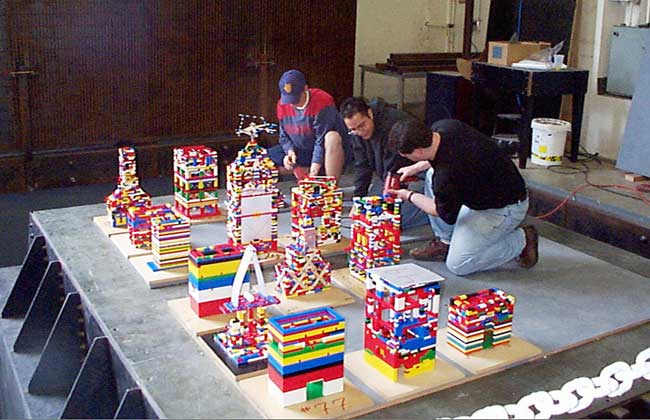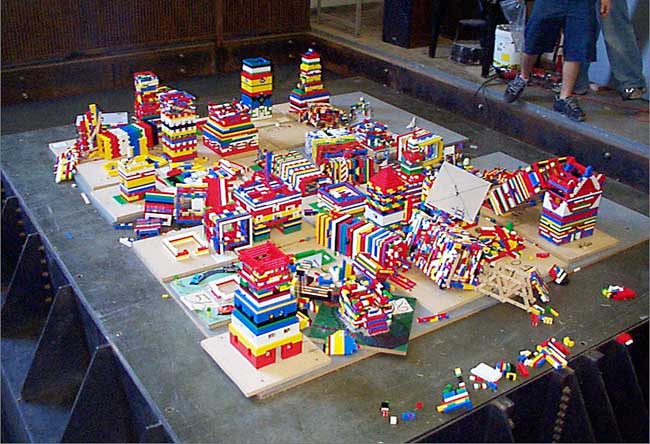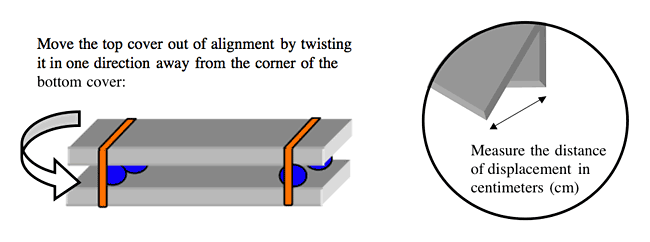Introduction
Once the tallest buildings in the world, the Petronas Towers in Kuala Lumpur, the capital of Malaysia, stand at 1,483 feet, which beat out the Sears Tower in Chicago, which previously held the record for the tallest building at 1,454 feet (WGBH, 2000). The building known as the tallest is always changing as technology allows engineers to build them higher. How do engineers build buildings so tall?

The Petronas Towers in Malaysia, previously the world's tallest buildings (WGBH, 2000).
An engineer designs a building to withstand forces. Forces come from many sources: gravity, people inside, weight of building materials, weather, and environmental impacts. If the design is stable, then these forces will not weaken the structure or cause the structure to collapse.
One type of force that can weaken a structure is a lateral shaking force, like that experienced during an earthquake. If an engineer is going to design a building in earthquake country, then they need to be sure that their design can withstand lateral forces. The Petronas Towers are an excellent example of this type of design because Malaysia is in an area that experiences frequent earthquake activity.
One way to test a design for stability to lateral forces is to use a shake-table. The shake-table will generate lateral movements, which will apply lateral forces to the model structures. One very large shake-table is at the Pacific Earthquake Engineering Research Center (PEER) at the Department of Civil and Environmental Engineering, University of California, Irvine. Here, they host an annual contest where student teams build and test their LEGO® buildings for stability.

At UC Irvine, students at the Learning With LEGO program get to see if their LEGO structures can handle the shake-table. You can see the LEGO structures before and after the shake (photos from PEER, Date Unknown).

In this experiment, you will build your own miniature shake-table which you will use to test your own LEGO buildings. By building structures of different heights, you will test if increasing the height of the structure has an effect on the stability of the building. Will your designs be able to take a shake?
Terms and Concepts
To do this type of experiment you should know what the following terms mean. Have an adult help you search the Internet, or take you to your local library to find out more!- height
- base
- area
- length
- width
- displacement
- lateral
- Are short buildings more stable than tall buildings?
- How will lateral shaking movements affect a building?
- How can I build a shake-table to test the stability of model buildings?
- Currently, what is the tallest tower in the world? How was it built?
Bibliography
- Read all about famous skyscrapers around the world at this site from the PBS series "Building Big":
WGBH, 2000. "Building BIG: All About Skyscrapers," PBS Online, WGBH Educational Foundation. [Accessed March 6, 2007] http://www.pbs.org/wgbh/buildingbig/skyscraper/index.html - Here is a simple design for a shake-table that you will use in this experiment:
RAFT, 2005. "Shake Table for Testing Structures in Earthquake Country," Resource Area for Teaching (RAFT), San Jose, CA. [Accessed March 6, 2007] http://www.raft.net/ideas/Shake%20Table.pdf - One inspiration for this project came from the Learning With LEGO program developed by the Pacific Earthquake Engineering Research Center (PEER) at the Department of Civil and Environmental Engineering, University of California, Irvine:
- PEER, Date Unknown. "Learning With LEGO: School-University Partnership (SUP) for Earthquake Engineering Education," Pacific Earthquake Engineering Research Center (PEER). [Accessed March 6, 2007] http://peer.berkeley.edu/education/videos_k12_shake.html
- UCI, 2003. "Shake, Rattle and Roll," Today@UCI, University of California, Irvine. [Accessed March 6, 2007] http://today.uci.edu/Features/profile_detail.asp?key=114
- Here are two science fair projects from students at the Selah Intermediate School in Selah, Washington that inspired this project idea:
- M., Ben, 2005. "The Effect of Wind Load on a Building ," Selah Intermediate School, Selah, WA. [Accessed March 6, 2007] http://www.selah.k12.wa.us/SOAR/SciProj2006/BenM.html
- G., Krista, 2002. "The Effect of Structural Height on Building Stability," Selah Intermediate School, Selah, WA. [Accessed March 6, 2007] http://www.selah.k12.wa.us/soar/sciproj2002/KristaG.html
Materials and Equipment
- LEGO bricks
- Flat LEGO plate, approximately 10 inches x 10 inches
- Ruler, metric
- 3-ring binder
- Scissors
- Small rubber balls of the same size, about 1 inch in diameter (4)
- Large rubber bands (2)
Experimental Procedure
- Cut the front and back covers off of a 3-ring binder with scissors.
- Place the two binder covers on top of one another.
- "Rubber band" the two together by stretching a rubber band around each end, about 1 inch from the edge of the boards.
- Insert the rubber balls between the boards at each corner, placing them about 5 cm in from the edges.
- The shake-table should now be assembled as shown in this diagram:

A simple shake-table design you can use for this experiment (RAFT, 2005). - Attach a large, flat LEGO mounting plate to the top of your shake-table by slipping it underneath the rubber bands. This will be where you mount your structures to the shake-table.
- Build a series of LEGO towers of increasing height. You should use the same base pattern for each tower, so that the size of the tower's footprint does not change and only the height will be different. You can double check this after you are finished by measuring the length and width of the base of each tower, and they should be the same.
- Measure the height of each tower in centimeters (cm) with the measuring stick. Write the height of each tower in a data table:
| Tower Height | Table Displacement (cm) | Did it Fall? (Y/N) |
- To test each tower, place it in the center of the top surface of the shake-table. Then you will pull the top layer of the shake-table out of alignment and then let it go to create a lateral shaking movement.

- The distance that you pull the top layer away from the bottom layer is called the "Displacement" and you should write this in your data table. Use a ruler to measure how far you have pulled the top layer out of alignment before you let go.
- Test each tower with increasing "Displacement" values until you find out when the tower will fall.
- Compare your results. Did all of the towers fall at the same "Displacement" values or were there differences? Did tall towers have different values than short towers?
very usefull
ReplyDeletetrue
Delete